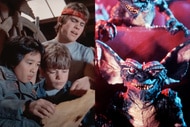Performance art meets horror comics: The work of Cynthia Von Buhler

Though Cynthia Von Buhler has been an artist since early childhood, she has become well known to modern audiences mostly due to a series of highly ambitious interactive theater events that have taken place in secluded locations in New York over the last decade. Beginning in 2011, her Speakeasy Dollhouse play series was initially funded through Kickstarter, and subsequently became one of the most highly talked-about performance art events of the last many years.
More recently, Von Buhler has turned her creative lens to the world of comics and has released graphic novels connected to her theatrical events. One, a four-issue mini-series based directly on historical events that quickly flies off the rails into a tale of pulp fantasy and murder, The Girl Who Handcuffed Houdini. Another, The Illuminati Ball, directly connected to a Speakeasy Dollhouse event of the same name.
Von Buhler's resume is one of the more difficult to chronologically track just due to its sheer volume, but suffice to say she did significant work as a performance artist, an illustrator, a writer of children's books, a professional singer, and much more well before ever releasing a graphic novel. Utilizing family stories to build amorphous, evolving mythology for a wide array of audiences to engage with has been a prominent feature of her work, culminating in her most recent series of interactive plays.
The first of the Speakeasy Dollhouse plays, The Bloody Beginning, explored the mysterious circumstances of her grandfather's real-world death. Setting up a series of plot elements based on historical happenings and allowing the audience to come to its own conclusions created a sort of choose-your-own-adventure live-action murder mystery. The event was held at an old hangout of Meyer Lansky (a cohort of Lucky Luciano's, infamously known as "The Mob's Accountant") in Lower East Side Manhattan. The audience was encouraged to dress in time-appropriate garb and to interact and have conversations with one another, creating an exciting, unscripted atmosphere.
Followup plays in the series focused around the assassination of President Lincoln at the hands of John Wilkes Booth and the death by poison of the tragically short-lived silent film ingenue Olive Thomas. Investigations into the last 1800s and early 1900s created epic historical backing to these immersive plays, but they also laid a lot of the groundwork for The Girl Who Handcuffed Houdini.
Based on the last three weeks of Harry Houdini's life, the comic opens on the story of a young woman named Minky Woodcock who tires of her position as a secretary at her father's agency. She meets Arthur Conan Doyle and is immediately sucked into a world of spiritualism, rampant sexuality, and fraudulent psychics. Though the comic tends to go in all directions at once, it does set the tone for the time period perfectly and gives us a 1920s pulp-inspired protagonist to rival the best of them. This graphic novel is set to be the basis of an upcoming play, so the story has yet to be fully realized, but the bizarre, surrealist imagery and excellent illustration of the book set its own unique tone, leading it to be dubbed one of the best independent trade paperbacks of 2018.
The 2019 follow-up, The Illuminati Ball, is another comic based on a real-life event. Much as with these prior shows, guests travel to an isolated estate with intricate set designs assembled by Von Buhler's team, consisting of 60 cast members and 25 crew members. This time around, the theme incorporates imagery from Marie-Hélène de Rothschild's ball held in 1972 in which several guests showed up in animal-themed costumery. Taking this inspiration as a chance to comment on intersections of suffering, cruelty, sexuality, secret societies, wealth and power, The Illuminati Ball is said to have been a surreal, unforgettable experience by attendees.
Meanwhile, the comic adaptation of the event is relatively straightforward in concept, utilizing classic storytelling elements to tell a tale of deception, power, and lust. Von Buhler's art hits a pinnacle here as the illustrations teem with electric energy. The chaotic elements of the story interweave with Von Buhler's vibrant color choices to create something that feels unique in direction if not in plot. The book, only around a hundred pages, could have gone for quite a bit longer without exhausting the many characters and concepts it introduces, but one supposes that the events themselves fill in a lot of the details of the experience.
Von Buhler's comics are fascinating artifacts of a uniquely creative mind in and of themselves, and their historical context is likely to find supporters both within and outside of genre. Yet perhaps the most interesting thing about them is the way that they condense immersive theatrical events into seemingly smaller, more compact portions while finding new, creative ways to expand. The Illuminati Ball and The Girl Who Handcuffed Houdini sometimes fit perfectly within the confines of the page, sometimes find new unexplored corners to explore within the page, and sometimes break out of the page entirely. This yearning for freedom within a confined space is consistent for much of Von Buhler's body of work as it stands today. Though her work changes medium, the themes and the goals remain consistent.































